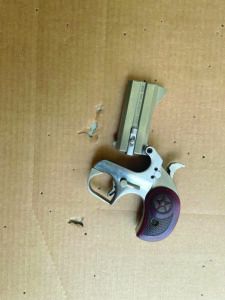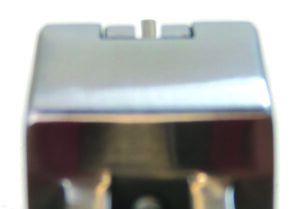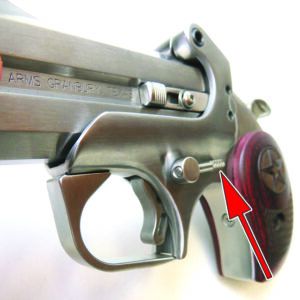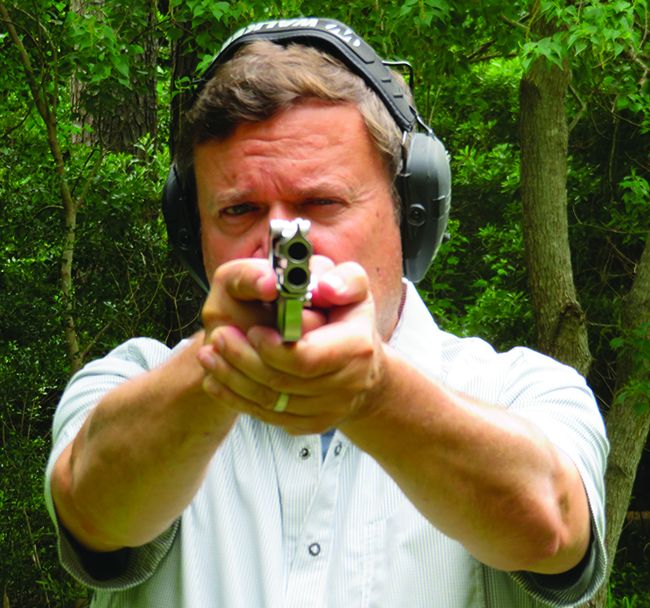The .410-bore cartridge has made inroads in the past few decades to become something other than an expert sub-gauge choice for skeet shooters or bird hunters. Now, the shotshell is being offered in massive revolvers with multiple-projectile payloads as well as other modern loads used to harvest turkeys at seemingly unbelievable ranges. Could a .410 be a viable defense gun that bucks the norm and makes a 9mm striker-fire pistol look plain and uninteresting? Don’t get us wrong, we are not going to trade in our semiautomatic pistols for defense purposes, but life offers options and the Henry Brass Axe, Taylor’s & Co. Howdah, and Bond Arms Defender are alternatives. Would we recommend one of these .410s instead of a pistol, revolver, shotgun, or rifle? Nope, but we embarked on this match-up journey with an open mind and discovered these three .410s are capable and darn fun to shoot.
The Taylor’s Howdah and the Bond Defender are also chambered in 45 Long Colt, giving the user the option to shoot shotshells or bullets. We’d opt for the shotshell option and choose cartridges such as Hornady’s Critical Defense .410 Triple Defense. This round fires three projectiles at once, and when the gun has only a two-round capacity, the more projectiles flying at the same time helps level the playing field between you and your adversaries.
How We Tested
We tested the Taylor’s and Bond with both cartridges and shells. The Henry only takes shotshells. For the .410 bore rounds, we fired Winchester Super X No. 71⁄2 shot game loads, Federal .410 Handgun loaded with No. 4 shot, and Hornady’s Critical Defense loaded with a .41-caliber FTX slug and two .35-caliber round balls. For 45 Colt pistol cartridges, we used Federal American Eagle loaded with a 225-grain jacketed soft point, SIG’s V-Crown with a 230-grain jacketed hollow-point bullet, and Hornady Critical Defense pistol rounds with 185-grain FTX bullets.
For action shooting, we used Thompson Target B27STOP Upper Torso Silhouette Targets, which are plain white or brown cardboard, depending on what side you use, with immobilization zones outlined. The perforated outlines are difficult to see from a distance, and the idea behind these targets is to be able to identify center of mass and smaller A-zone shots. These were set at 10 yards. For accuracy testing, we fired with a two-hand hold with no support. These defense guns are designed to be used at close distance, and 10 yards could be considered the maximum effective distance. Translated into real-world terms, that means the distance across a bedroom and down a hall or the length of a parking spot. While firing, we looked for pattern density and tight groups, ease of use, and reliability. Here’s what we uncovered.
Gun Tests Grade: A-
$499
The Bond Arms Texas Defender derringer is a solid hunk of stainless steel, and in hand it sits low so you have easy access to the hammer and can cock it back. Shooting it takes a bit of re-training. We found that using the pad of our finger and pulling down on the spur trigger instead of straight back was the best option. We also tried manipulating the trigger with our support hand and that worked, too.
| Action | Derringer, break action, hammer fired |
| Trigger | Single Action Only |
| Overall Length | 5.0 in. |
| Overall Height | 3.7 in. |
| Maximum Width | 1.2 in. |
| Weight Unloaded | 20 oz. |
| Weight Loaded | 21.7 oz. |
| Barrel | 3.0 in. |
| Capacity | 2 |
| Frame | Matte stainless steel |
| Frame Front Strap Height | 1.6 in. |
| Frame Back Strap Height | 2.1 in. |
| Grip | Checkered wood |
| Grip Thickness (Maximum) | 1.3 in. |
| Grip Circumference (Maximum) | 5.0 in. |
| Sights | Integral |
| Trigger Pull Weight | 5.0 lbs. |
| Trigger Span | 3.0 in. |
| Manual Safety | Thumb, half-cock, rebounding hammer |
| Warranty | 3 years |
| Website | BondArms.com |
| Made In | U.S. |

The challenge with the Defender is the small grip. Cocking the hammer with our support hand allowed us to shoot the Defender fast. We could get two fingers on the front grip strap, and when we finally figured out the best way to press the trigger, we were golden. Recoil is stout but manageable. The wide, fat grip really helped to spread recoil out in our hand, even with the hot 45 LC and .410 defense loads, but we wouldn’t want to spend an entire day shooting the Defender.
A two-shot derringer would not be our choice for a home defense gun, but as a deep-conceal weapon for close encounters, it has potential due to the chambering of 45 LC/.410. The edge this weapon has is surprise, and a solid hit on one or two of your attackers will allow you to run away and fight another day, or get to cover and reload.
Like all Bond Arms derringers, the barrels and caliber can be swapped out, allowing you to shoot anything from 9mm and 45 Auto to 38 Special and 357 Magnum. We like the 45 LC chambering since it allows use of .410 shotshells, which can dispatch snakes of all kinds.

For sighting, the front post and rear-sight notch are integral to the top of the barrels. The rear-sight notch is above the hinge where the barrel pivots open to load and unload. A small lever on the left side of the frame is depressed to pivot open the barrels. With the barrels loaded, swing them back and they snap closed. A manual extractor is built into the barrel to eject cases. There is a trigger guard to protect the spur trigger from being accidentally pressed. A crossbolt safety and the rebounding hammer are safety features allowing you to carry the Defender concealed without worry.
The weight of the Defender, 21.7 ounces loaded, is helpful, especially when firing powerful defense rounds. We found we could still carry this beast in our pants pockets, but that was not practical unless we wore a belt and suspenders. A small IWB holster is a better choice. The hammer is large and is easily snagged in a pocket, but with your thumb placed over the hammer, the Defender can be quick to put into action.

At 10 yards, accuracy with the Defender is a challenge, with groups averaging from 3 to 4 inches. Still this is acceptable accuracy. In fact, the SIG V-Crown ammo gave a best group that measured 2 inches. The Defender excelled at punching 45-caliber holes in the center of mass, but more surgical head shots took effort with the Defender. We’d stick to center-of-mass shots.
Moving to shotshells, the Winchester Super X game loads and Federal Personal Defense were ineffective. The short barrels on the Defender do not allow the shot to form a dense pattern nor the shot charge to achieve maximum muzzle velocity, and we suspect the penetration would not be effective. The patterns measured 30 inches at 10 yards with these shot shells. So you may stun an attacker, but you would not immobilize him. We advise to use shot only if you are trying to send a cottonmouth over the Rainbow Bridge. The Hornady Critical Defense load is an excellent option to make this mouse-size gun roar. Pattern size measured 6.5 inches. This would be our pick because you can hit a target with three projectiles at the same time in a fairly dense pattern. We did note a few fired Hornady shells needed to be ejected out of the barrel using a pen. Other than that, the Bond worked flawlessly.
Our Team Said: The Defender loaded with .410 defense loads is formidable, but it is a close-range weapon with limited capacity. If you have a need to whack water moccasins or rats in the barn, the Defender loaded with shot is a good choice.
.410 Bore Shotshell and 45 LC Range Data
.410 Bore, 2.5 Inch
| Winchester Super X ½ oz., No. 7½ shot | Henry Brass Axe .410 | Taylor’s & Co. Howdah | Bond Arms Defender |
| Pattern Size | 6.0 in. | 18.0 in. | 30.0 in. |
| Federal Personal Defense 7⁄16 oz., No. 4 | Henry Brass Axe .410 | Taylor’s & Co. Howdah | Bond Arms Defender |
| Pattern Size | 4.0 in. | 18.0 in. | 30.0 in. |
| Hornady Critical Defense .410 Triple Defense | Henry Brass Axe .410 | Taylor’s & Co. Howdah | Bond Arms Defender |
| Pattern Size | 1.5 in. | 4.5 in. | 6.5 in. |
45 Long Colt
| Hornady Critical Defense 185-grain FTX | Henry Brass Axe .410 | Taylor’s & Co. Howdah | Bond Arms Defender |
| Average Velocity | NA | 920 fps | 830 fps |
| Muzzle Energy | NA | 348 ft.-lbs. | 231 ft.-lbs. |
| Smallest Group | NA | 3.0 in. | 3.2 in. |
| Average Group | NA | 3.5 in. | 3.6 in. |
| SIG V-Crown 230-grain JHP | Henry Brass Axe .410 | Taylor’s & Co. Howdah | Bond Arms Defender |
| Average Velocity | NA | 912 fps | 750 fps |
| Muzzle Energy | NA | 425 ft.-lbs. | 287 ft.-lbs. |
| Smallest Group | NA | 2.0 in. | 2.0 in. |
| Average Group | NA | 3.0 in. | 3.0 in. |
| Federal American Eagle 225-grain JSP | Henry Brass Axe .410 | Taylor’s & Co. Howdah | Bond Arms Defender |
| Average Velocity | NA | 860 fps | 760 fps |
| Muzzle Energy | NA | 370 ft.-lbs. | 281 ft.-lbs. |
| Smallest Group | NA | 3.4 in. | 3.0 in. |
| Average Group | NA | 3.9 in. | 3.8 in. |



























